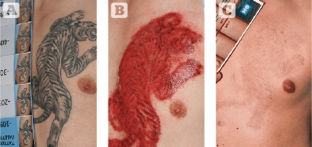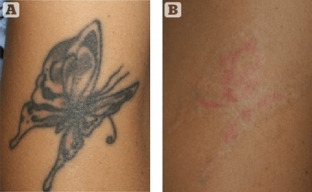Leonardo Marini explains how the use of sequential multilayer fractional and maximum intensity Q-switched laser technology can improve tattoo removal results.
Numerous studies have confirmed that tattoo pigments do not remain in the dermis. Over time, they enter the lymph nodes, where they can interfere with the interpretation of diagnostic tests and surgical procedures. This side effect of tattoos is little known to the general public, but it is one of the reasons why patients seek tattoo removal.
Tattoo Removal Lasers: The Gold Standard
Nanosecond and picosecond laser systems have revolutionized tattoo removal procedures as they are the ideal technological embodiment of selective photothermolysis theory applied to microscopic targets. Their peak power, as well as ultra-short pulse duration, makes it possible to limit the destructive effect of laser systems on medium particles of tattoo ink (40 nm), while not affecting non-pigmented peripheral cells and tissues. Laser procedures with a single beam passage and Q-switching, despite their effectiveness, allow you to achieve the desired results on average only after 8-12 (and sometimes more) sessions with an interval of 2-3 months. Therefore, this tattoo removal technology requires great patience on the part of patients and doctors.
Nanosecond and picosecond laser systems are considered the gold standard among tattoo removal procedures.
Since the first removal of black tattoo pigment in 1983 (Reid et al.) with a Q-switched ruby laser, such techniques have improved. Traumatic tattoos and tattoos accompanied by complications in the form of allergic reactions are successfully removed by ablative fractional lasers that are not sensitive to pigments.
Picosecond laser systems achieve results in 4-6 sessions on average, which are achieved with single-pass laser beam technologies and Q-switching in 8-12 sessions.
Read also: Features of laser tattoo removal
Q-switched laser tattoo removal with picosecond lasers comes with risks and side effects. However, they are minimal compared to millisecond lasers and laser systems based on pulses of high intensity light, which should not be used for tattoo removal.

The use of lasers for tattoo removal can be improved by increasing the transepidermal removal of ink particles and optimizing lymph flow or blocking rephagocytosis after the procedure.
Combined Q-switched multi-layer procedures have been proposed to improve the tattoo removal process. In a study by Kossida T et al., four successive laser passes were performed in a single laser session (method R-20). Twenty-minute intervals between passages are necessary to ensure the release of cavitation bubbles through the epidermal layers of the skin. This innovative procedure, despite being difficult to replicate in clinical practice due to its complexity, has significantly reduced the number of sessions required for tattoo removal, with minimal transient side effects. Topical application of perfluorodecalin has been suggested to correct epidermal lightening following Q-switched laser application.
Innovative combined laser treatments for tattoo removalIn many areas of laser dermatology, sequential combinations of multiple laser treatments have shown better clinical results than single technologies. With regard to Q-switched lasers, it has been demonstrated that multiple consecutive passes within a single session can increase the effectiveness of intradermal pigment removal without increasing the risk of complications and side effects. Combining fractional ablative treatment with 2940 nm Er:YAG or 10600 nm Already after the first session of laser tattoo removal for ablative
Successive application of fractional ablative treatment with 2940 nm Er:YAG or 10600 nm COLaser tattoo removal is not a painless procedure, especially when large anatomical areas or multiple treatments are required. Therefore, the author resorted to subdermal administration of local anesthesia on all tattooed areas (1% Mepivacaine + 1:200,000 epinephrine). Epinephrine was chosen to induce temporary vasoconstriction in order to reduce unnecessary light absorption by hemoglobin during the procedure. In addition, special protective goggles and ear protection are required during operation due to the high-pitched noise resulting from the photoacoustic effect.2 lasers and Q-switched lasers proved to be more effective than using each laser technology separately.

(A) Single color tattoo on left chest. (B) Immediately after the 1st session according to the author's protocol. (C) Clinical result after 4 sessions (1 preparatory pass with 1064 nm fractional laser and 2 passes with 1064 nm laser with maximum beam intensity and Q-switching).
After getting excellent results, the author decided to test another Q-switched sequential laser treatment technology using QX Max (Fotona, Slovenia).A preliminary "fractional preparation" was carried out using a Q-switched fractional handpiece with the ability to produce twenty-five 250 µm microdots in a 5 mm x 5 mm area. The 1064 nm wavelength of the Nd:YAG laser was chosen due to its deeper optical penetration. High energy - up to 12.7 J/cm
2 and superposition of pulses (6-10) were used for complete treatment of all tattooed areas. Five-minute intervals were sufficient to stop the capillary bleeding, which ensured the further safety and effectiveness of laser exposure. In 90% of cases (in 20 people), complete removal of the pigment was observed after 4 sessions. Moreover, the author managed to improve skin color and eliminate textural imperfections of hard-to-remove tattoos.
Healing after combined use of lasers for tattoo removalAfter each treatment and during the acute inflammation stage, the treated areas were covered with sterile paraffin-impregnated gauze and a thin layer of active moisturizing alginate coating (Flaminal Forte, Flen-Pharma, Belgium) with excellent hygroscopic and antimicrobial properties. The last layer of the coating was a sterile absorbent pad and a special gauze (TNT gauze). Class 1 compression stockings were also required to be worn (and removed at night) for tattoo removal on the lower extremities to improve lymphatic drainage.

(A) Two tone tattoo on right forearm. (B) Clinical result after 4 treatments (1 pass of the 1064 nm fractional laser and 2 runs of the 1064 nm and 532 nm lasers with maximum beam intensity and Q-switching). The presence of red pigment is due to the deep location of the tattoo ink particles, which are not easy to remove with a wave of 532 nm.
Home dressing changing procedures were performed 2-3 times a day for the first 3-5 days after the procedure.The purpose of the second step of dressing was to promote cell proliferation during healing. At this stage, a sterile silicone gel (Stratamed, Switzerland) was applied to the treated area. After drying, the silicone film was covered with a thin hydrocolloid pad. This procedure was carried out once a day until a homogeneous, even pinkish layer of the epidermis appeared.
At the last stage, to optimize early remodeling, 0.05% clobetasol propionate was applied to the skin twice a day, 2-3 days a week (for 2-3 months). Also, before the next session of laser removal, a topical remodeling wound healing cream was prescribed, which had to be applied to the treated area 2-3 times a day.






Add a comment